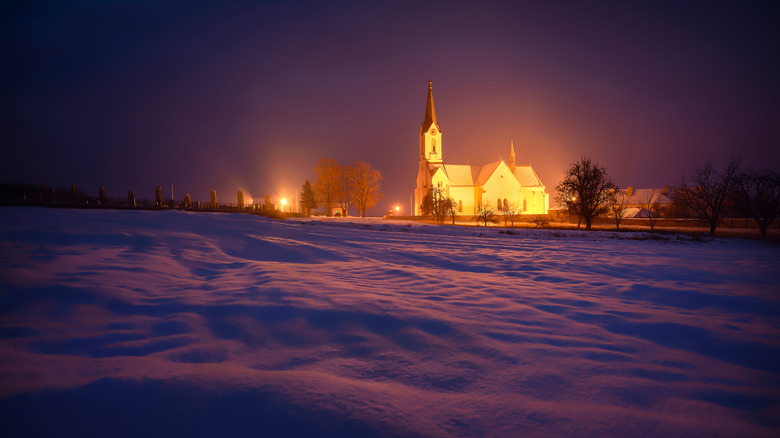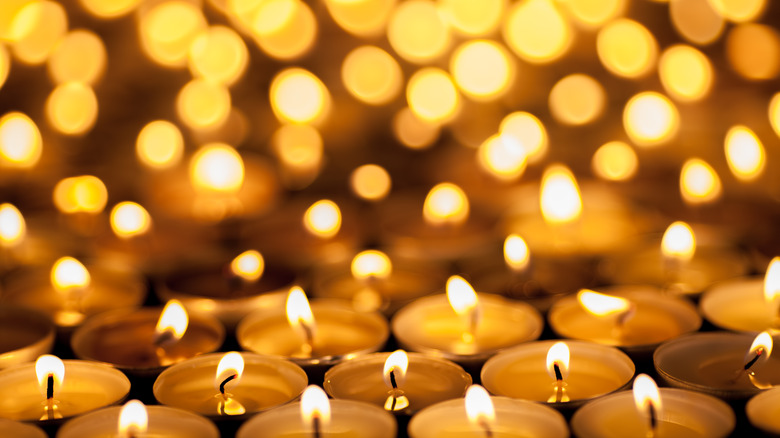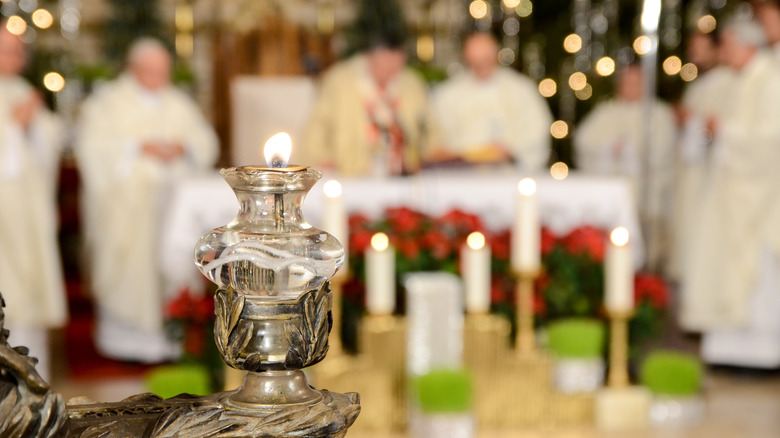Where Does Catholicism's Midnight Mass Come From?
It's that most wonderful time of year again: Snowmen, Santa, Christmas trees, Mariah Carey, and of course, annual visits to that place you might otherwise never think about, church. Yes, Christmas is indeed the time when many of the faithful emerge to fulfill their religious responsibilities for the year. According to Lifeway Research, 48% of Protestant pastors report that Christmas Eve is their fullest service of the holiday season, with attendance building to that point and then sharply dropping off afterward.
On the Catholic side of things, Crisis Magazine reported that 64% of Catholics went to Christmas mass pre-COVID. But Catholics have more rules and greater ritualistic complexities to contend with. The National Catholic Register, for instance, reports that in 2023 the duly pious need to attend a separate Sunday mass aside from a usual Christmas mass because Christmas Eve falls on a Sunday. Got that?
At the same time, Catholics have options. The Archdiocese of Detroit — one archdiocese out of 35, nationwide — has an honest-to-goodness Mass Finder where folks can peruse nearly 800 Christmas Eve services throughout the day at 3:30pm, 4:00pm, 4:15pm, 4:30pm, 5:00pm, etc.
And then there's that most iconic of Christmas masses: The Midnight Mass, which The Pillar says Pope St. Sixtus III started in 440 C.E. in the Church of St. Mary Major in Rome. Honoring the traditional birth time of Jesus at midnight, this "mass during the night" has continued and evolved since then.
A 1,600-year-old tradition
To be fair, The Pillar says that there's no such canonical thing as a "Midnight Mass" — that's just an informal title. And yet, our earliest records indicate that by the 4th century C.E. there was at least a precedent for nighttime Christian religious ceremonies. Taking sources at face value, the School of Mary discusses a woman named Egeria whose 381 to 384 C.E. writings describe Christian practices of the time, including an allusion to Midnight Masses under the header "Evening Offices." Egeria, however, was describing how Christians might end celebrations that had started Good Friday, not how they might conduct themselves at times celebrating Jesus' customary birthdate.
Egeria writes, "Those of the clergy, however, who are strong or young keep vigil there, and hymns and antiphons are said throughout the whole night until morning; a very great crowd also keep night-long watch, some from the late hour and some from midnight, as they are able." Basically, if anyone was hale and healthy enough to continue services, particularly clergy, those people were encouraged to go above and beyond. For everyone else, "it is known that the people are tired" and they can opt out. This is especially true because up until that point during the day she describes very prescriptive and detailed sets of rituals, particularly the "emotion" and "mourning by all the people at every lesson and prayer."
Exactly how all this inspired Pope Sixtus III to conduct a midnight mass in 440 C.E. is unknown.
An ideal time for a Christian narrative
Pastoral Liturgy goes deeper into uncovering the origins of Midnight Masses by looking at the kind of early Christian practices described by Egeria. By the 4th century C.E., the Christian liturgical year was still in flux, and in need of a capstone. "Piety and tourism went hand in hand" at the time, as the Holy Land was already a tourist hotspot for the faithful. Those faithful, it turns out, would benefit from designated holy days built into a binding narrative.
Back in 221 C.E. Christian theologian Sextus Julius Africanus had decided on December 25 as Jesus's birthdate, although the first "Christmas" celebration (don't think anything modern) didn't appear until 336 C.E. History.com explains that Romans of the day still celebrated their traditional midwinter festivals towards the end of December, although Christianity grew and spread during this time nonetheless. By the time Emperor Constantine made Christianity Rome's state religion in 380 C.E., and folks like Egeria were documenting their early Christian practices (381 to 384 C.E.), Christianity itself needed coherence.
As Pastoral Liturgy says, a nighttime mass fit the "synoptic infancy narrative" of Jesus, magi, and angels, far better than its preceding "during the day" mass. It was a way for Christians to wase into the Jesus birth tale at a time when the tale took place, especially ahead of the coming, very symbolic dawn. Ultimately, a Midnight Mass simply felt right, and this is what made it stick through the centuries.


